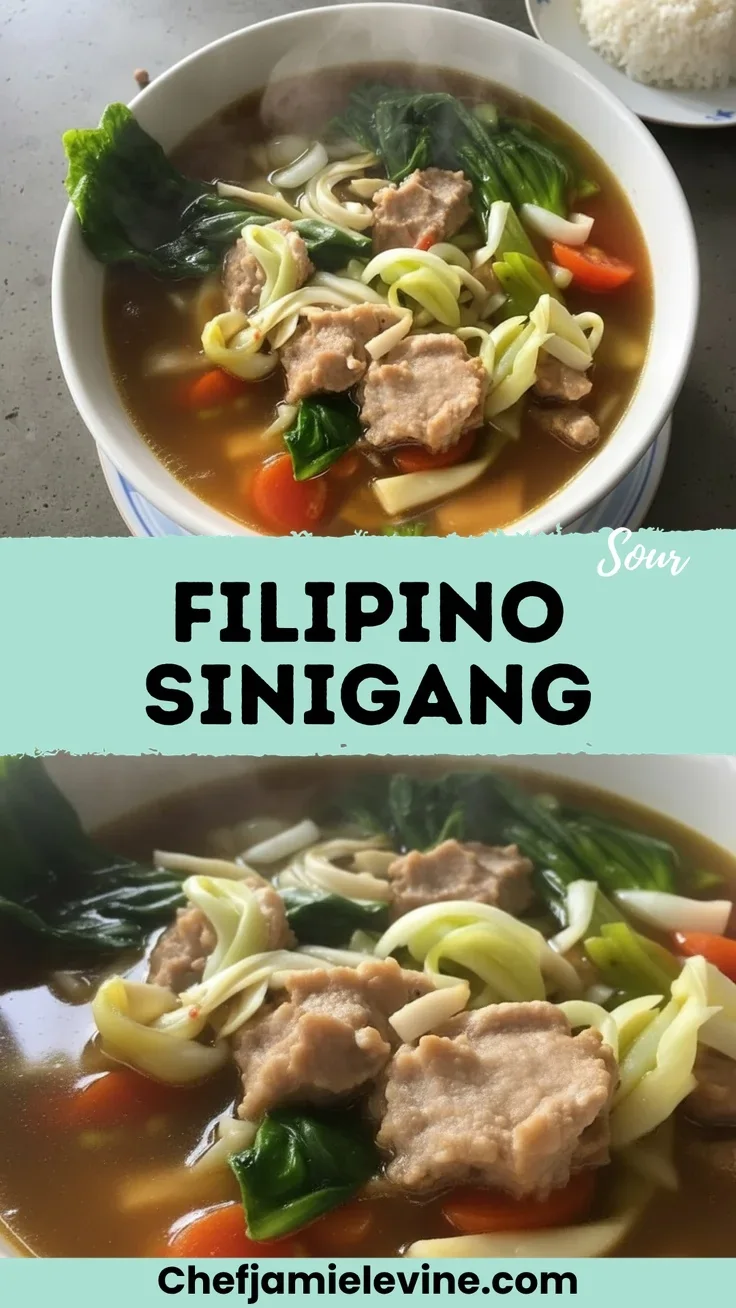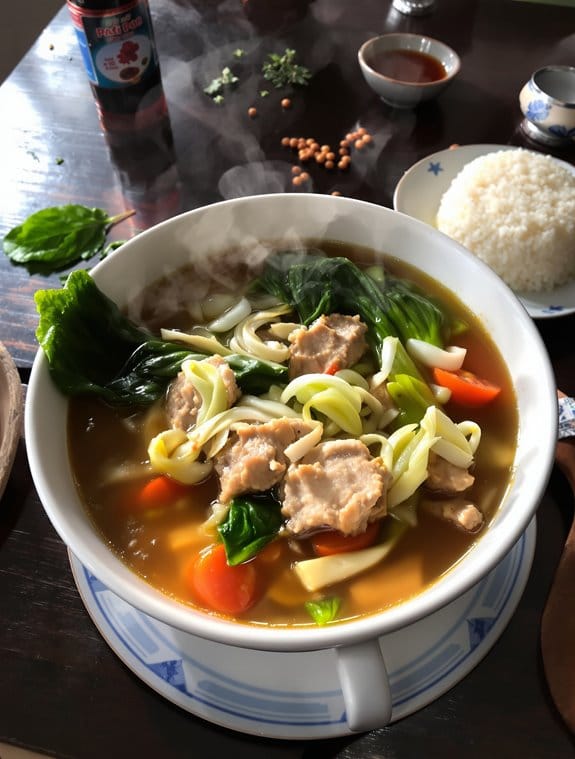Why You’ll Love this Comforting Filipino Sinigang
Whenever I’m craving something warm and soul-soothing, Filipino sinigang is my go-to comfort food. This tangy, savory soup strikes the perfect balance between sour and umami flavors, with tender meat that practically falls apart in your mouth.
What makes it so special? The combination of tomatoes, onions, and that magical sinigang packet creates a broth that’s both complex and comforting.
I love how versatile it is—you can use pork, beef, or seafood depending on your mood. The wilted greens add a nutritious touch, while the steaming rice served alongside soaks up all that flavorful broth.
Trust me, one spoonful and you’re hooked.
What Ingredients are in Comforting Filipino Sinigang?
Sinigang is all about layers of flavor—tangy, savory, and oh-so-comforting. The beauty of this Filipino classic lies in its simple yet powerful combination of ingredients that create that signature sour broth.
I’m always amazed at how a handful of everyday items can transform into something so deeply satisfying. Ready to discover what goes into this soul-warming soup? Let’s break down everything you’ll need to create this Filipino comfort food in your own kitchen.
- 2 pounds of meat (pork, beef, or seafood)
- 1 tablespoon cooking oil
- 2 garlic cloves, mashed
- 1 large onion
- 2 Roma tomatoes (or one large tomato)
- 1 tablespoon patis (fish sauce)
- 9 cups water
- 1 packet (1.4 oz) sinigang soup mix
- 5 small bok choy or 2 cups baby spinach
- Steamed rice for serving
The meat you choose really sets the tone for your sinigang. Traditional versions often use pork belly or ribs, but don’t feel limited—shrimp, fish, or even beef works beautifully.
The sinigang soup mix packet is the secret weapon here, providing that distinctive sour flavor that defines the dish.
Can’t find bok choy? Baby spinach makes a perfect substitute, though any leafy green that wilts nicely will do the trick.
And remember, the fish sauce (patis) is essential for that deep umami backbone—fish sauce skeptics, trust me on this one, it doesn’t make the dish fishy but rather adds incredible depth.
How to Make this Comforting Filipino Sinigang

Making sinigang is like orchestrating a delicious symphony of flavors—tangy, savory, and incredibly comforting. Start by heating 1 tablespoon of oil in a large pot over medium heat. Add your 2 mashed garlic cloves and 1 large onion, letting them gently brown and release their aromatics. This fragrant foundation is what builds the character of your broth.
Next, toss in your 2 Roma tomatoes, cooking until they begin to soften and break down slightly, then stir in 1 tablespoon of patis (fish sauce) to bring that essential depth of flavor.
Now for the star of the show—your chosen 2 pounds of meat. Whether you’re using pork, beef, or planning to add seafood later, brown it lightly in the pot to seal in those juices. Once browned, pour in 9 cups of water and bring everything to a rolling boil. If you’ve opted for seafood instead of meat, this is when you’d add it, cooking for just 20 minutes instead of the longer time needed for other proteins.
Reduce the heat to medium-low and let your meat simmer away for about 40 minutes, giving it time to become tender and infuse the broth with its flavor. The magic moment comes when you add that 1.4 oz packet of sinigang soup mix, transforming your broth into that signature tangy masterpiece that defines this Filipino classic.
For the finishing touch, add your 5 small bok choy or 2 cups of baby spinach and simmer just until wilted—about 5 minutes is all it takes. The greens should be tender but still vibrant, providing a fresh contrast to the rich, tangy broth.
Ladle your sinigang into bowls alongside steamed rice, which serves as the perfect canvas for soaking up all that flavorful broth. For those who love an extra punch of umami, serve additional patis on the side.
There’s something so deeply satisfying about that first spoonful of hot, sour broth hitting your palate—it’s like a warm hug in food form, especially welcome on chilly evenings or when you’re feeling under the weather.
Comforting Filipino Sinigang Substitutions and Variations
While traditional sinigang is beloved for its distinctive sour broth, I’ve found that this Filipino comfort food welcomes creative adaptations based on what’s in your pantry.
Don’t have pork? Try chicken, shrimp, or even fish—they all work beautifully. Vegetarians can skip meat entirely and double up on veggies.
No tamarind? Use lemon, lime, or even a splash of vinegar to create that signature tang. The greens are flexible too; swap bok choy for spinach, kale, or whatever leafy greens you have on hand.
Sometimes I add extra vegetables like okra or eggplant when I’m craving more substance in my bowl.
What to Serve with Comforting Filipino Sinigang
No Filipino meal is complete without thoughtful accompaniments to complement the tangy, savory goodness of sinigang.
The star pairing, of course, is steaming white rice—an absolute must. Its neutral flavor absorbs the broth perfectly, creating that satisfying spoonful we all crave.
I like to serve patis (fish sauce) on the side for guests who want an extra punch of saltiness. Sometimes I’ll add a small plate of sliced fresh chilies too, for heat-lovers in my family.
For a complete spread, consider adding crispy fried fish or lumpia as contrasting textures.
Trust me, nothing beats the comfort of this soul-warming combination.
Final Thoughts
After preparing this Filipino classic countless times over the years, I’ve come to appreciate sinigang as more than just a recipe—it’s a cultural touchstone that brings families together.
The tangy, soul-warming broth never fails to transport me back to rainy afternoons in Manila, when nothing satisfied quite like a steaming bowl of sinigang.
What makes this dish special? Perhaps it’s the perfect balance of sour and savory, or maybe it’s the versatility that welcomes any protein.
Whatever your choice—pork, shrimp, or fish—sinigang adapts while maintaining its comforting essence.
Try it once, and I guarantee it’ll earn a permanent spot in your recipe rotation.

Filipino Sinigang
Ingredients
Equipment
Method
- Heat oil in a large pot over medium heat. Add mashed garlic and onion, cooking until lightly browned and fragrant.
- Add tomatoes and cook until slightly softened. Stir in fish sauce (patis).
- Add your chosen meat and lightly brown it in the pot. If using seafood instead, skip this step and add it later.
- Pour in water and bring to a rolling boil. Reduce heat to medium-low and simmer meat for about 40 minutes until tender. (For seafood, add it now and cook for only 20 minutes instead.)
- Add the sinigang soup mix, stirring to dissolve completely.
- Add bok choy or baby spinach and simmer just until wilted, about 5 minutes.
- Serve hot with steamed rice on the side and additional fish sauce if desired.



